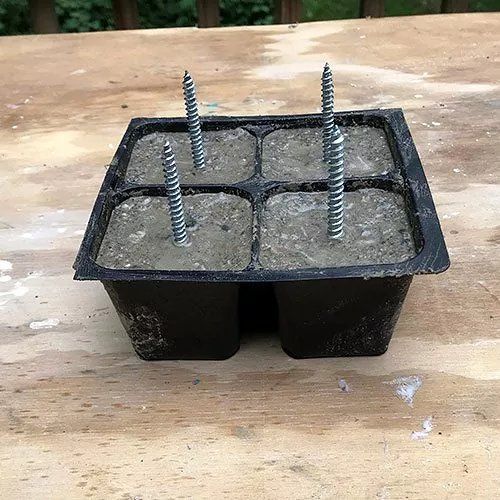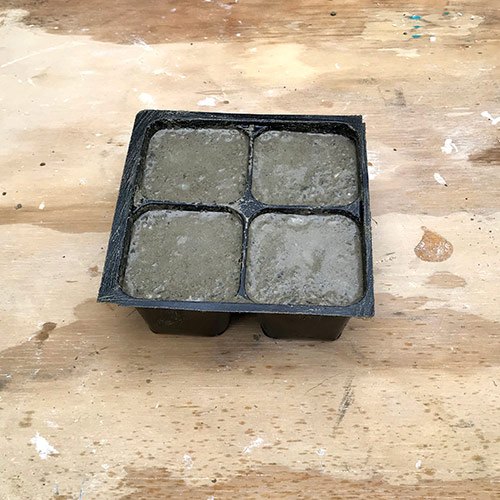
Spray the vegetable oil into the planter mould and pour in the concrete. Wait about 10-15 minutes, then push the head of a screw into each container with concrete so that they are about an inch in.
Make sure they are in the center and are straight and level.
Note: These will cure in about an hour, and you shouldn’t attach them until they have hardened more. The following day is ideal.


While they are curing- during that first hour, you should check back a couple of times to make sure they stay centered, straight and level. I tried using tape to keep these upright, but it was just easier to fiddle with them.
Also, I recommend not moving them too much within the concrete or they will be too loose to screw into the beam. If one does get loose like one of mine did, it’s okay because I have a fix, which I’ll get to in Step 6 below.

Flip the beam over to the opposite side, that’s the side you will drill the holes for the feet. Mark the center location for two of the concrete feet for each end. Now mark them out at about 5″ down from the end.
Next, to mark the center of each foot, measure in at 1 ¼” from each side. Then drill a pilot hole that fits the width of the screws in the concrete feet. You’ll want to make sure you will be able to screw in your legs without hitting the one next to it, but these will be attached in Step 6.


You will have to test these as you go to make sure you drill enough holes of the right size for the size branches you have. It’s a bit of trial and error.

** For another cool way to spruce up your patio, check out my Cinder Block Planter Wall! 
Next, move to the medium size bit and drill to each side of the large holes in an off center pattern.

Go ahead and put all the medium and large branches into the holes. Most of your branches are not likely to be straight, so think about what direction you want them to go.
This bunch that I got from Ikea for this project was very flexible, almost rubbery which made them less likely to break in the process.
When I originally made the first version years ago, the branches were straighter and more brittle.
The branches for this privacy fence were pretty curvy and so I let them flare outward, but you may want them facing more inward or sideways.

If you end up with a screw that is loose within the concrete and it won’t screw it in, then make the hole a little larger and add some construction adhesive (or similar) to the hole.
Construction adhesive is nice and gooey so it fills in the space decently. Then just push in the foot with screw, rather than twisting it and let it dry an hour or so before moving on to the next step.

**Keep the lights on the roll they came with, take special precaution not to let the string slip off the roll or you will end up with a knotted ball of lights like I did, and you will have to constantly unknot.
** To make it easier, you can weave the lights mid-way up the branches and then slide the wire down after.
Get someone to help you gently flip it over to stand up right and position it. Sit down with a glass of wine, beer or coffee and enjoy some privacy with your fence.

General materials

Concrete materials

LED fairy lights

For Ingredients And Complete Cooking Instructions Please Head On Over To Next Page Or Open button (>) and don’t forget to SHARE with your Facebook friends





